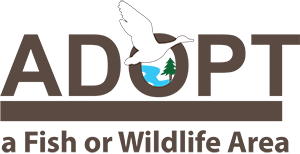Dunnville Wildlife Area
Dunnville Wildlife Area, commonly referred to locally as the "Dunnville Bottoms," is a 4,200-acre property located between Menomonie and Durand, bound by the Chippewa River on the south and County Highway Y and 210th Avenue on the north. Access to this property can be gained through four parking areas off of Highway Y or through numerous parking areas off of the following town roads: 524th, 580th, 640th and 660th streets. Access to the south side of the property is also possible via boat from the Chippewa River.
Habitat on the Dunnville Wildlife Area is quite diverse. Expansive sand beaches are common along the Chippewa River. Moving inland, large areas of floodplain forest are common. Interspersed within this forest environment are backwater sloughs and some rather large openings containing prairie and oak savanna. Further from the river, steep hillsides dominated by oaks and other northern hardwoods are common. Atop the hills is a plateau consisting of mostly mixed hardwoods, jack pine barrens, and an 80-acre red pine plantation.
Nearly a quarter of the wildlife area's acreage (more than 900 acres) is managed as prairie or oak savanna, including approximately 200 acres of native remnants that have never been farmed.
Management Objectives
History
The Dunnville Wildlife Area started as a leased public hunting ground in 1951 in response to a petition from the Dunn County Fish and Game Association to the Wisconsin Conservation Department. The original lease was on 3,200 acres. In 1952, the Conservation Department purchased 40 acres from Dunn County under the authority of the Scattered Wetlands Program. In 1967, Dunnville Wildlife Area was established as a project with a goal of 3,507 acres. In 1979, the acreage goal was revised to the current 5,707 acres. This wildlife area is currently an active acquisition area, with additional lands added as recently as 2009.
This portion of Dunn County is of historical significance because of its location at the confluence of the Red Cedar and Chippewa rivers. The prevalence of steamboat traffic on the rivers made the village of Dunnville a prominent community that at one time was even the county seat of Dunn County. By the late 1880s, however, steamboat traffic had been replaced by the railroad and the population of Dunnville was on the decline. Today, there are but a few reminders of days gone by.
Historically, the primary management objective for Dunnville was to provide hunting and other outdoor recreation opportunities for the people of Dunn County. As lands were acquired, marginal farm fields were converted to prairie to complement the existing native prairie community and provide additional wildlife habitat and hunting opportunity.
Management Objective
Current management objectives focus on protecting the watersheds of the Red Cedar and Chippewa rivers and managing for presettlement vegetation types. This includes maintaining existing prairies and savannas and seeking opportunities to increase these cover types. The property in managed on a landscape scale, creating smooth transitions between cover types. Phasing out planted red pines to allow for the conversion to oak and jack pine barrens in some locations is another important management objective.
The property is monitored for invasive species such as buckthorn and garlic mustard. Prairie and savanna areas are managed and maintained through prescribed burning, mowing and occasional herbicide use to limit brush encroachment and encourage a vigorous grassland. Wetlands are managed through limited disturbance to prevent the spread of reed canary grass. Woodlands are managed in a manner that limits the spread of oak wilt and encourages regeneration of floodplain forests.
For more information on master planning for this and other wildlife areas around the state, visit the property planning page.
Property Features
This property lies along the north bank of the Chippewa River with approximately 5 miles of frontage. Dunnville also includes frontage on both banks of the Red Cedar River, extending from the confluence with the Chippewa River roughly 2.5 miles upstream. A large, handicap accessible boat landing can be found along County Highway Y on the Red Cedar River.
All of Dunnville Wildlife Area is part of the Lower Chippewa River State Natural Area, which is known throughout the state for its numerous unique qualities.
Of archaeological significance, two prehistoric mound groups first reported in 1908 and 1909 were located within the boundaries of the wildlife area. One group of mounds has been lost while the other, a group of 24 mounds, is still evident, though some of the mounds have been vandalized extensively.
The Red Cedar State Trail also bisects the Dunnville Wildlife Area. The trail begins in Menomonie and follows the Red Cedar River through Downsville and southward through the wildlife area before crossing an old train trestle bridge and culminating at the Chippewa River State Trail. The Red Cedar Trail is open to hikers and bicyclists in the summer, and a portion of the trail is open to snowmobiles in the winter. Traveling the Red Cedar Trail provides a nice glimpse of the interior of Dunnville Wildlife Area.
Recreation
-
The Dunnville Wildlife Area offers many recreational opportunities:
- Biking (Red Cedar State Trail);
- Birding;
- Camping on state-owned islands and sandbars along the Chippewa River excluding the area between the Red Cedar State Trail and the mouth of the Red Cedar River;
- Canoeing;
- Cross-country skiing (no designated trail);
- Fishing;
- Hiking (Red Cedar State Trail);
- Hunting (12 PM closure for pheasant hunting);
- Trapping;
- Snowmobiling trail (a portion of the Red Cedar State Trail);
- Swimming;
- Wild edibles/gathering; and
- Wildlife viewing.
Maps
Download [PDF] a map of this property.
If you are interested in exploring this property further, you can access an interactive map.
Find out more about how to adopt this wildlife area.

